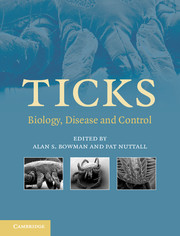Book contents
- Frontmatter
- Contents
- List of contributors
- Preface
- 1 Systematics and evolution of ticks with a list of valid genus and species names
- 2 The impact of tick ecology on pathogen transmission dynamics
- 3 Tick salivary glands: the physiology of tick water balance and their role in pathogen trafficking and transmission
- 4 Tick saliva: from pharmacology and biochemistry to transcriptome analysis and functional genomics
- 5 Tick toxins: perspectives on paralysis and other forms of toxicoses caused by ticks
- 6 Tick lectins and fibrinogen-related proteins
- 7 Endocrinology of tick development and reproduction
- 8 Factors that determine sperm precedence in ticks, spiders and insects: a comparative study
- 9 Tick immunobiology
- 10 Saliva-assisted transmission of tick-borne pathogens
- 11 Lyme borreliosis in Europe and North America
- 12 Viruses transmitted by ticks
- 13 Babesiosis of cattle
- 14 Theileria: life cycle stages associated with the ixodid tick vector
- 15 Characterization of the tick–pathogen–host interface of the tick-borne rickettsia Anaplasma marginale
- 16 Emerging and emergent tick-borne infections
- 17 Analysing and predicting the occurrence of ticks and tick-borne diseases using GIS
- 18 Acaricides for controlling ticks on cattle and the problem of acaricide resistance
- 19 Anti-tick vaccines
- 20 Anti-tick biological control agents: assessment and future perspectives
- 21 Pheromones and other semiochemicals of ticks and their use in tick control
- Index
- References
5 - Tick toxins: perspectives on paralysis and other forms of toxicoses caused by ticks
Published online by Cambridge University Press: 21 August 2009
- Frontmatter
- Contents
- List of contributors
- Preface
- 1 Systematics and evolution of ticks with a list of valid genus and species names
- 2 The impact of tick ecology on pathogen transmission dynamics
- 3 Tick salivary glands: the physiology of tick water balance and their role in pathogen trafficking and transmission
- 4 Tick saliva: from pharmacology and biochemistry to transcriptome analysis and functional genomics
- 5 Tick toxins: perspectives on paralysis and other forms of toxicoses caused by ticks
- 6 Tick lectins and fibrinogen-related proteins
- 7 Endocrinology of tick development and reproduction
- 8 Factors that determine sperm precedence in ticks, spiders and insects: a comparative study
- 9 Tick immunobiology
- 10 Saliva-assisted transmission of tick-borne pathogens
- 11 Lyme borreliosis in Europe and North America
- 12 Viruses transmitted by ticks
- 13 Babesiosis of cattle
- 14 Theileria: life cycle stages associated with the ixodid tick vector
- 15 Characterization of the tick–pathogen–host interface of the tick-borne rickettsia Anaplasma marginale
- 16 Emerging and emergent tick-borne infections
- 17 Analysing and predicting the occurrence of ticks and tick-borne diseases using GIS
- 18 Acaricides for controlling ticks on cattle and the problem of acaricide resistance
- 19 Anti-tick vaccines
- 20 Anti-tick biological control agents: assessment and future perspectives
- 21 Pheromones and other semiochemicals of ticks and their use in tick control
- Index
- References
Summary
INTRODUCTION
Tick toxicosis has been a research focus for almost 80 years and during this time, several excellent reviews on this subject have been written that cover the history of toxicosis research as well as its aetiology and pathology (Gregson, 1943, 1973; Stampa, 1959; Neitz, 1962; Murnaghan & O'Rouke, 1978; Gothe, Kunze & Hoogstraal, 1979; Gothe, 1984, 1999; Wikel, 1984; Gothe & Neitz, 1991; Sonenshine, 1993; Masina & Broady, 1999). A comprehensive monograph on tick toxicoses of all forms has also been published (Gothe, 1999).
FUNCTIONAL SIGNIFICANCE OF TICK TOXINS
While arthropods such as spiders and scorpions are notoriously venomous organisms that utilize their toxins for protection as well as predation, the advantages for ticks being toxic is unclear. It has been suggested that tick paralysis may be a vestigial function conserved in ticks, when ticks evolved a parasitic lifestyle (Stone et al., 1989). Paralysis toxins have been attributed to functional significance during feeding of the tick, in that host mobility and grooming is impaired. This might be relevant, as tick paralysis sets in at the later stages of tick engorgement, when the tick is most liable to be killed by grooming practices. Paralysis would also affect the respiratory system leading to elevated breathing rates and an increase in carbon dioxide expiration. This together with pheromone secretion could attract ticks to the paralysed animal, which accelerates the finding and feeding of ticks.
- Type
- Chapter
- Information
- TicksBiology, Disease and Control, pp. 108 - 126Publisher: Cambridge University PressPrint publication year: 2008
References
- 12
- Cited by

